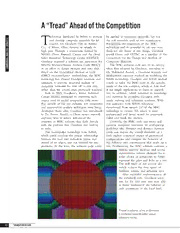
NASA Technical Reports Server (NTRS) 20020080315: A "Tread" Ahead of the Competition PDF
Preview NASA Technical Reports Server (NTRS) 20020080315: A "Tread" Ahead of the Competition
A “Tread” Ahead of the Competition T echnology developed by NASA to evaluate be applied to numerous materials, but not S F and develop composite materials for jet the soft materials used in tire construction. F O N engines has Goodyear Tire & Rubber Recognizing the magnitude of the MAC PI —S Co., of Akron, Ohio, turning its wheels in technology and its potential to set new stan- S FIT high gear. Through a consortium formed by dards for the future of tire design, Goodyear E N NASA’s Glenn Research Center and the Great joined Glenn and GLITeC as a member of the E B L Lakes Industrial Technology Center (GLITeC), Consortium for the Design and Analysis of A CI Goodyear acquired a software use agreement for Composite Materials. R E M NASA’s Micromechanics Analysis Code (MAC), The MAC software code was in its infancy M CO in an effort to design stronger and safer tires. when first adopted by Goodyear, according to Based on the Generalized Method of Cells Dr. Mahmoud Assaad, a Goodyear research and (GMC) micromechanics methodology, the MAC development associate involved in modifying the technology has allowed Goodyear scientists and NASA technology. Goodyear and NASA worked engineers to perform structural analysis of jointly to tailor the MAC code to the specific composite laminates for tires all in one step, needs of the tire company, which at first used rather than the several steps previously required. it for simple applications to learn its capabili- Back in 1995, Goodyear’s Akron Technical ties. In addition, NASA extended its knowledge Center became interested in improving tech- and expertise by providing Goodyear with niques used to model composites, fully aware onsite training and education seminars. With that outside of the tire industry, soft composites this assistance from NASA, Goodyear and macro-micro analysis techniques were being transitioned from version 2.0 of the MAC developed. Soon after, Goodyear was introduced technology to version 3.0, which is more to Dr. Steven Arnold, a Glenn senior research sophisticated and better suited for pneumatic engineer, who in return introduced the radial and truck tire analysis. company to MAC software that dealt directly Currently, the MAC code can assess and with the problem that Goodyear was looking optimize composite laminates; set cord-spacing to solve. guidelines (the diameter and distance between This leading-edge technology from NASA, cords may impact the overall durability of a which could simulate the proper relationship tire); explain structural impact of geometrical between the load and deflection (stress and configurations; and compare the behavior of strain) of an object, was not tailored for tire the different wire constructions that make up a problems. At the time, the software code could tire. Furthermore, the MAC software contains a built-in material database and several representative volume elements for a wider choice of composites to better represent the plies and belts in a tire. The end result of the process ulti- mately reduces the time spent on building, testing, and adjusting tires. After successful implementation of the enhanced code, Goodyear scien- tists for the first time ever were able to better understand the behavior of each constituent at the local level, Virtual simulation of tire performance is conducted regularly before actual laboratory testing. 72 TRANSPORTATION and thus were able to provide the company’s S tire designers with opportunities to explore new F F O applications to enhance overall tire performance. N PI Further testing of the microanalysis code —S S demonstrated that the MAC tires achieved a FIT E 22- and 35-percent improvement in high speed N E B and low speed durability tests, respectively, L A compared with conventional tires. The MAC CI R E technology has been applied to composite M M laminate designs for several commercially CO available Goodyear models, including a Kelly- Springfield passenger tire, and a LT235/85R16 Safari tire. Goodyear is currently advancing its analysis capabilities by utilizing the next level of MAC technology known as FEAMAC, a NASA- developed, seamless integration of MAC’s micromechanics analysis capabilities, within the commercial, non-linear, finite element code called ABAQUS. The anticipated future applications for FEAMAC within Goodyear are vast, since tasks that required several hours to complete are now being accomplished within 45 minutes, on average. Goodyear scientists believe that FEAMAC will substantially improve the company’s evaluation process for the structural behavior of tires, as well as the over-all longevity of its future line of commercial tires. While NASA’s MAC technology has been provided to other companies, Dr. Assaad proudly notes that Goodyear is driving the software application to “uncharted areas” NASA’s Dr. Steven Arnold (left) and Goodyear Tire & regarding rubber composite materials. ❖ Rubber Co.’s Dr. Mahmoud Assaad inspect a MAC- manufactured tire for surface appearance, after it had been subjected to X-ray examination. TRANSPORTATION 73
